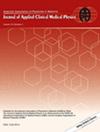An investigation into the feasibility and efficacy of stereotactic radiosurgery for 1–3 cm single brain lesions on the ring-mounted Halcyon LINAC
Abstract
Purpose
An evaluation of the accuracy, safety, and efficiency of the Halcyon ring delivery system (RDS) for stereotactic radiosurgery (SRS) treatment to relatively small (1–3 cm) brain lesions.
Methods
After completing the extensive in-house quality assurance checks including Winston–Lutz test and independent dose verification via MD Anderson IROC SRS head phantom irradiation on Halcyon, fifteen brain SRS patients previously treated with a single dose of 20 Gy on TrueBeam (6MV-FFF) with HyperArc geometry were retrospectively replanned on Halcyon (6MV-FFF). Plan quality metrics including conformity index (CI), gradient index (GI), gradient distance (GD), PTV coverage, gross tumor volume (GTV) dose, heterogeneity index (HI), and doses to organs-at-risk (OAR) including normal brain dose were evaluated. Patient-specific quality assurance (PSQA) and independent dose verification via in-house Monte Carlo (MC) 2nd checks were performed.
Results
The Halcyon was able to provide highly conformal brain SRS plans. When compared to TrueBeam, CI, planning target volume (PTV) coverage, GTV dose (mean and minimum), HI, and doses to brainstem, optic pathway, and cochlea were statistically insignificant. Statistically significant increases in GI (3.76 vs. 3.25, p < 0.001), GD (0.56 cm vs. 0.48 cm, p = 0.001), and V12Gy (5.5 cc vs. 4.6 cc, p = 0.014), on average using Halcyon versus TrueBeam was found, albeit clinically acceptable values for the majority of brain SRS cases. Halcyon plans provided statistically insignificant maximum dose to most adjacent OARs, though there was a statistically significant decrease in the maximum dose to the spinal cord (0.1 Gy vs. 0.4 Gy, p = 0.009). Halcyon beam-on time increases by a factor of ∼2 (p < 0.001). However, the faster patient setup on Halcyon results in a comparable estimated overall treatment time for both platforms. Plan deliverability and accuracy was ensured with PSQA (> 95% pass rate for 2%/2 mm clinical gamma criteria) results and MC 2nd check agreement within ± 5.0%.
Conclusions
Halcyon brain SRS plans provided a similar plan quality compared to HyperArc plans, although it demonstrated an inferior intermediate dose fall off thus slightly higher V12Gy. This study suggests that Halcyon provides acceptable treatment for solitary relatively small brain lesions of 1–3 cm in diameter. Treatment of select patients on Halcyon will be started at our clinic and it is recommended that other clinics complete an end-to-end test, validate, and implement Halcyon SRS treatments at their practices, especially community cancer centers to provide high-quality service to an underserved patient cohort.

 求助内容:
求助内容: 应助结果提醒方式:
应助结果提醒方式:


